What happens at the beginning of Mass?
At the start of Mass, when those processing in reach the sanctuary, they bow to the altar, even if the tabernacle is in a different chapel. And bishops, priests and deacons kiss the altar. Why?
That’s because according to St. Ambrose (late 300s) the altar is a symbol of Christ. The liturgy calls Jesus Christ priest, victim and altar: As High Priest, he makes the offering (Hebrews 5:1-10). As Victim, he is the one being sacrificed, the Lamb who was slain (Revelation 13:8).
But why the altar? St. Paul says we “offer our bodies as a living sacrifice, holy and pleasing to God, our spiritual worship” (Romans 12:1). Since we know the Father accepts Christ’s sacrifice, we place our lives on Christ himself; he is the one through whom we sacrifice our lives. Reverencing the altar is reverencing Christ himself.
Greeting
The celebrant greets the assembly with the Sign of the Cross and a scriptural text such as, “The grace and peace of God our Father and the Lord Jesus Christ be with you” (Titus 1:4).
This is much richer than merely saying, “Good morning.” No matter how much the priest and people like one another, something more is happening: The priest is wishing God upon the people, and the people respond not just to the man, but to Jesus Christ himself.
That’s why the translation of the people’s response is, “And with your spirit.” Christ greets his bride (the church), and the bride greets the spirit of Christ present in the priest.
Penitential rite
Are you ready to meet Jesus, who really comes to us in the Eucharist? Sometimes, neither am I. That’s why we usually ask for mercy next. This can take several forms: The most ancient predates even the use of Latin in Mass: We cry out “Kyrie eleison,” Greek for “Lord have mercy.”
The Confiteor (“I confess . . .”) first shows up around the eighth century. And sometimes, such as at Easter and Masses with baptism, we renew our baptismal promises and replace the penitential rite with a sprinkling with water.
The Gloria comes from the song the angels sang at Jesus’ birth (Luke 2:4) and originally was used only during the Christmas season. It found its way into Mass during the sixth century. Christ is born anew in each Mass we celebrate, and we sing his praises with the angels and saints who are continually praising him. Each time we pray Mass, we join with the liturgy already going on in heaven (Catechism of the Catholic Church, 1090).
Opening prayer
The opening prayer is also called the “collect.” The priest intones, “Let us pray,” and then a brief silence follows. The silence is not just waiting for the altar server to bring the book; each of us is supposed to be praying silently during that time, and after a short while the priest “collects” all those silent prayers into the opening prayer. When the priest ends, we all acclaim “Amen!” signaling our agreement with the prayer, and we are ready for God to speak to us next in the Liturgy of the Word.
To read about the other parts of the Mass and what’s happening, and why, check out the other articles in this series under the Related Content section below.
About Father Tom Margevicius
Father Tom Margevičius worked for the Ohio Department of Natural Resources before joining the National Evangelization Teams (NET) and working for St. Paul’s Outreach in the Twin Cities. He is a full-time instructor at the St. Paul Seminary. He has served the parishes of Nativity in St. Paul, St. John the Baptist in Dayton, and currently is also pastor of Our Lady of Mt. Carmel in Northeast Minneapolis, where he celebrates the sacraments in Sign Language for the deaf.
© 2007 Rev. Thomas Margevicius
Used with permission.



